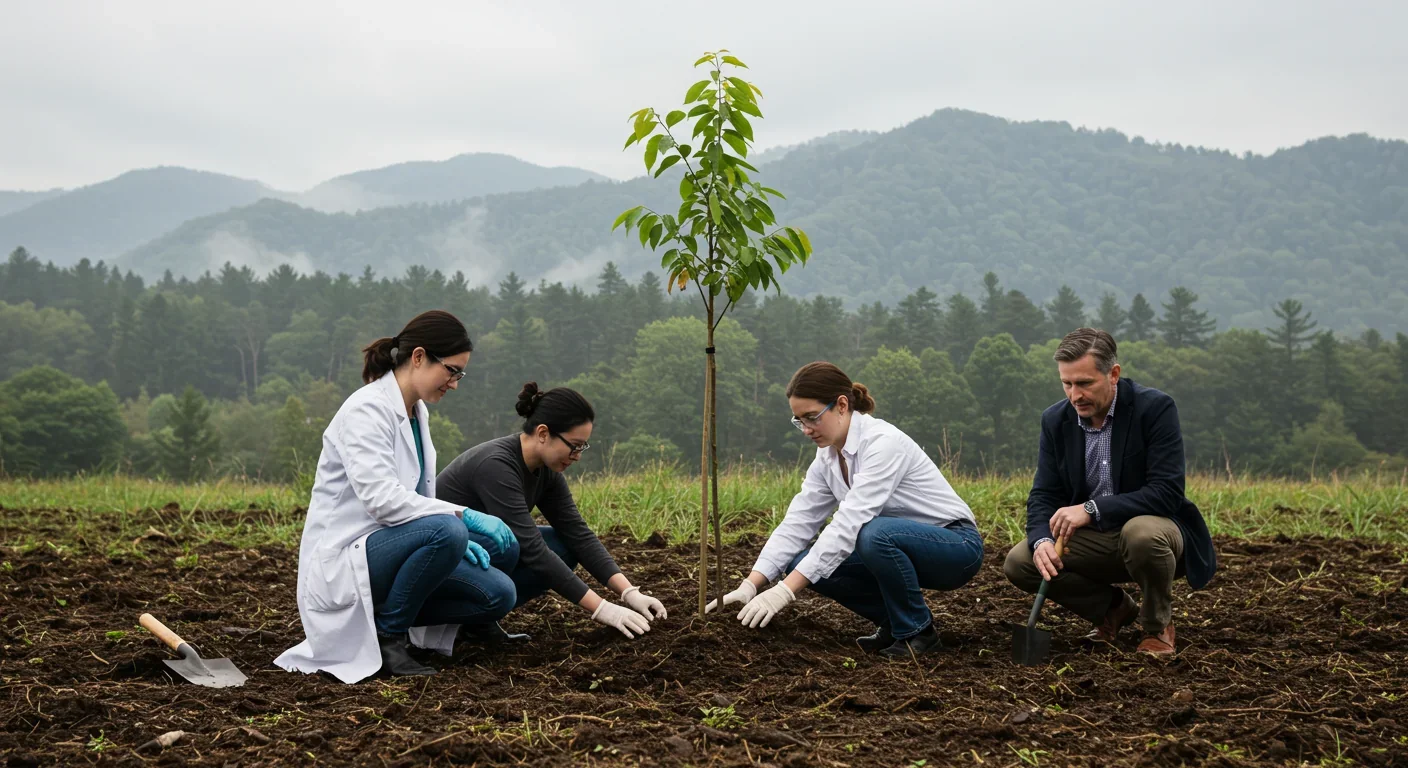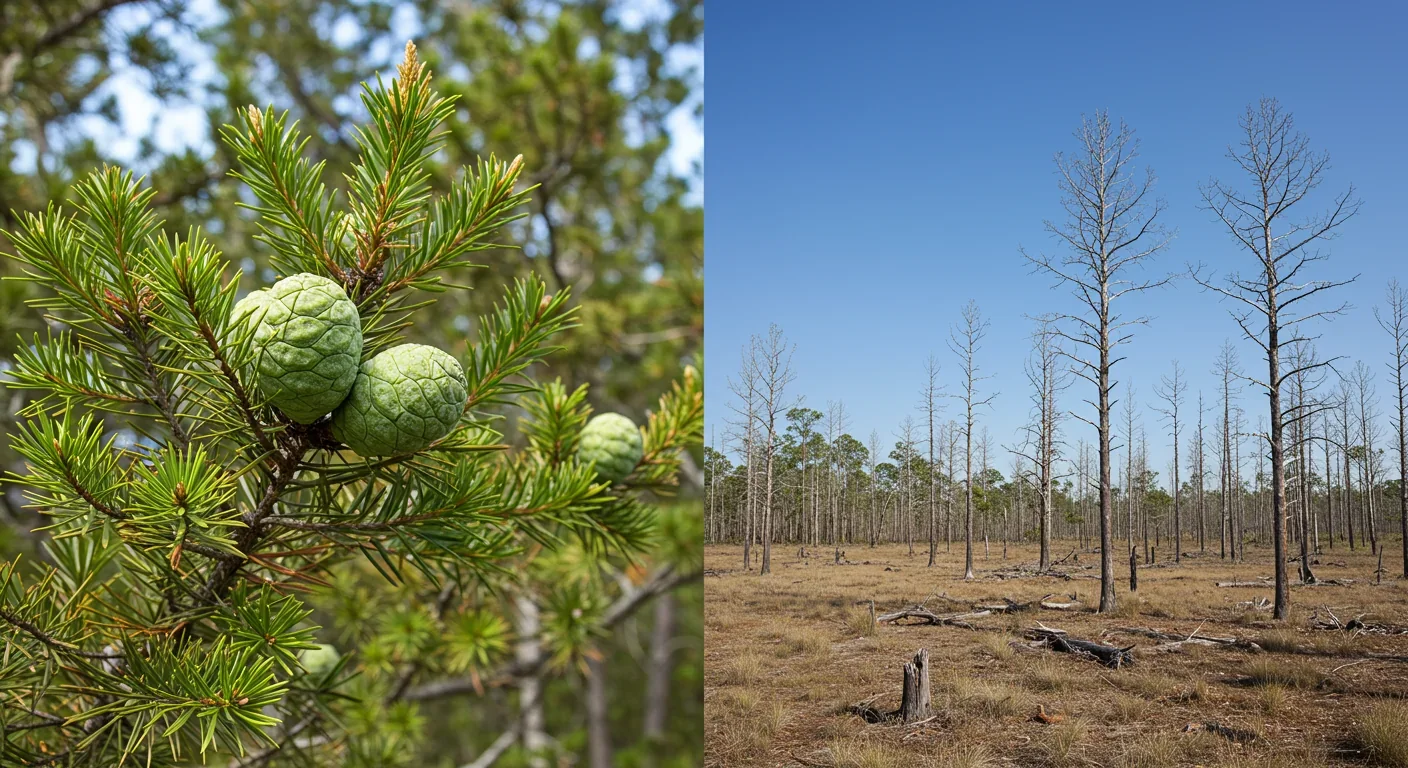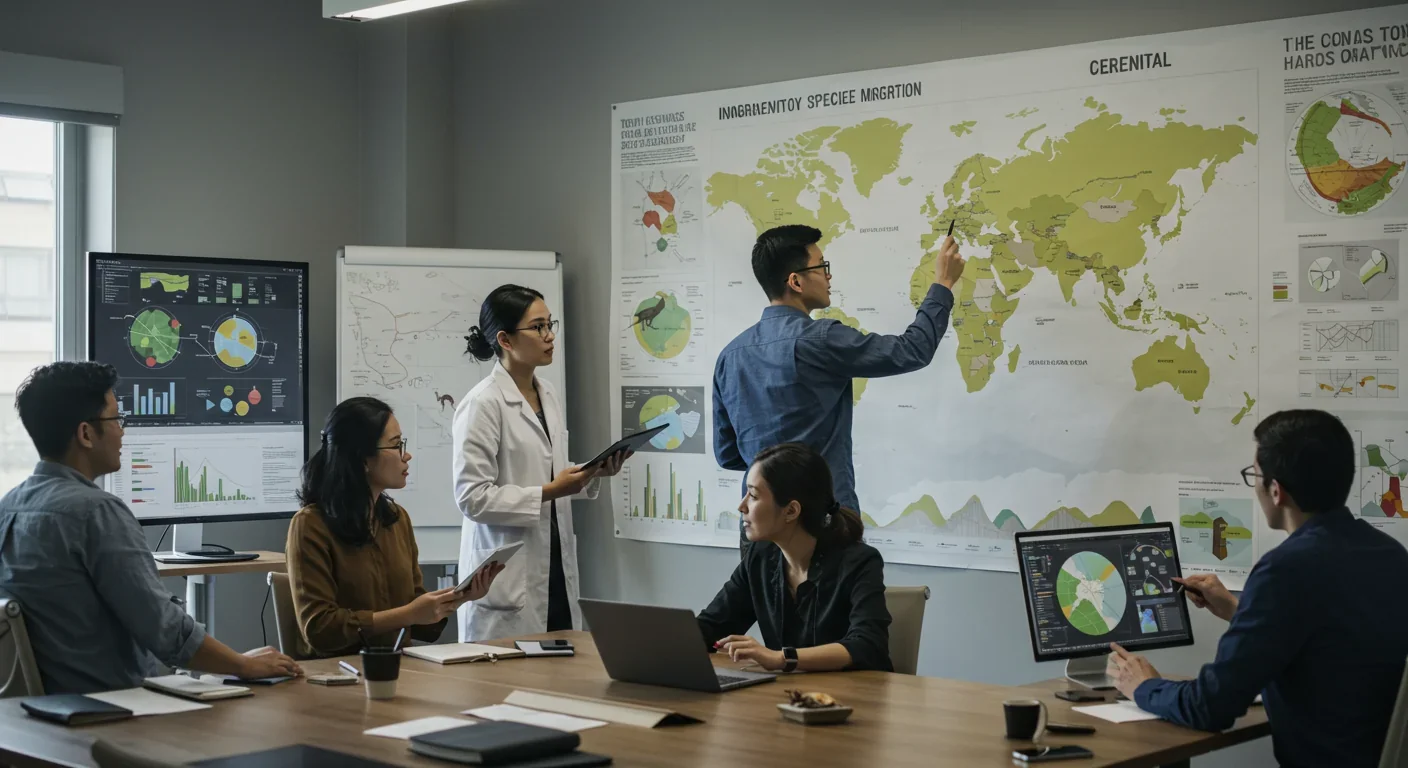Digital Pollution Tax: Can It Save Data Centers?

TL;DR: As climate change accelerates, scientists are relocating species to cooler habitats in a controversial practice called assisted migration. Early successes like Florida torreya trees thriving in Ohio show promise, but the strategy risks creating invasive species and ecosystem disruption. With models predicting a quarter of species could face extinction this century without help, conservationists are developing frameworks to balance extinction prevention against ecological risks—sparking fierce debate over whether humans should redesign nature to save it.

In a forest grove north of Cleveland, Ohio, something remarkable is happening. Florida torreya trees, once confined to a tiny pocket of northern Florida, are producing seeds hundreds of miles from their ancestral home. These aren't escapees or accidental transplants. Scientists deliberately moved them there because climate change was killing them in Florida. The trees are thriving. Their offspring are spreading. And conservationists around the world are watching closely, because this experiment might be our best hope for preventing mass extinctions — or it could trigger ecological catastrophes we can't predict.
Welcome to the controversial frontier of assisted migration: physically relocating species to escape climate change. As temperatures rise and habitats shift, many species face a brutal choice that isn't really a choice at all — move or die. The problem? Most can't move fast enough on their own.
Here's the uncomfortable truth climate scientists don't often spell out: species need to migrate at speeds that would make their ancestors dizzy. Research shows many plants and animals need to shift their ranges by 3.25 kilometers per year just to track suitable temperatures as the planet warms. For context, that's like a tree walking from San Francisco to Portland in a human lifetime.
Most species can't do it. Seeds don't disperse that far. Animals face fragmented landscapes, highways, and cities blocking traditional migration routes. The Florida torreya's natural range collapsed from 700,000 trees to roughly 700 individuals over the past century. Without human intervention, extinction seemed inevitable.
Climate change is accelerating this crisis. Models suggest that up to a quarter of Earth's species could go extinct this century if they can't track shifting climate zones. Natural dispersal rates, honed over millions of years of evolution, are suddenly obsolete in a world warming at unprecedented speed.
This is where assisted migration enters the picture. Rather than watch species vanish, some scientists argue we should become nature's moving company — carefully selecting species, identifying suitable future habitats, and physically relocating them before it's too late.
The results from early projects have been tantalizing enough to fuel serious interest. Beyond the Florida torreya, several other assisted migration experiments have shown promise.
Consider the bay checkerspot butterfly in Britain. Scientists used ecological niche modeling — essentially predicting where species could survive based on their current habitat preferences — to identify unoccupied sites that matched the butterfly's climate needs. They moved populations to these cooler locations. The butterflies not only survived; they colonized the new areas just as the models predicted. It was a validation both of the concept and the predictive tools conservationists could use to guide future relocations.
Black bears in Arkansas tell a similar story, though not specifically for climate reasons. The translocation of just 254 bears to the Ozark Mountains resulted in a population exceeding 2,500 individuals within 11 years. The project demonstrated that well-designed relocations, using wild populations and carefully selected sites, could achieve dramatic conservation successes.
The Torreya Guardians, a citizen-science group dedicated to saving the Florida torreya, documented thriving populations in at least a dozen legacy horticultural sites across North Carolina by 2018. The trees weren't just alive — they were producing viable seeds and subsequent saplings, evidence of genuine establishment rather than temporary survival.
These successes fuel optimism. But they also mask the profound uncertainties and risks that make assisted migration one of conservation's most divisive strategies.
Here's where the ethical debates get heated. Every successful assisted migration could theoretically become tomorrow's ecological disaster. History offers sobering lessons about introducing species to new environments.
The risk of creating invasive species looms over every translocation proposal. Critics point to countless examples of well-intentioned introductions that spiraled into nightmares — kudzu vine smothering southern forests, cane toads devastating Australian ecosystems, zebra mussels clogging waterways. In each case, humans moved a species outside its native range, and the new ecosystem had no evolutionary defense.
But assisted migration proponents counter with a crucial distinction: most historical invasions happened over vast distances, typically continent to continent. One review of 468 documented species invasions found only 14.7% occurred on the same continent where the species originated. Assisted migration, by contrast, typically involves much shorter moves within the same continent — relocating species to habitats just north or upslope of their current range, tracking the climate zones they evolved in rather than leaping to entirely foreign ecosystems.
Still, the risks aren't trivial. Species could outcompete natives in their new homes. They could hybridize with closely related species, muddling distinct genetic lineages. They could introduce diseases or parasites. They could alter ecosystem processes in unpredictable ways — nutrient cycling, fire regimes, water availability.
And there's the wild card: we're not just moving species into stable ecosystems. We're moving them into ecosystems that are themselves in flux due to climate change. Long-term ecological interactions — who eats whom, who pollinates what, who competes for which resources — remain deeply uncertain. Short-term niche models might successfully predict immediate survival, but they can't foresee how communities will reorganize over decades as multiple species shift simultaneously.
The hurricane risk adds another layer of vulnerability. When Hurricane Michael struck Florida's Torreya State Park in 2018, it destroyed an entire stand of 700 recently transplanted torreya trees. Climate change is increasing the frequency and severity of extreme weather events, meaning relocated populations might face catastrophic losses even in "suitable" habitats.

Faced with such high stakes, conservationists have developed systematic frameworks to evaluate assisted migration proposals. These aren't gut decisions; they're based on ecological modeling, risk assessment, and genetic analysis.
Ecological niche modeling forms the foundation. Scientists compile data on where a species currently lives — temperature ranges, precipitation patterns, soil types, associated species — and project where those conditions will exist in the future under various climate scenarios. This identifies potential relocation sites. The bay checkerspot butterfly success validated this approach, but uncertainties about long-term community interactions remain.
Trait-based risk assessment offers a complementary tool. Recent research by Thomas Nuhfer and Bethany Bradley examined which plant traits predict both successful establishment and invasive potential. They found an intriguing paradox: the same traits that help invasive species thrive — high metabolic rates, rapid growth, wind-dispersed seeds — also help relocated native species establish in new areas.
The key is filtering carefully. Large size and toxicity, for instance, correlate with unchecked spread and ecosystem impact. So the framework becomes nuanced: select for traits that aid establishment (stress tolerance, fast germination) while screening out traits that promote invasiveness (allelopathy, lack of natural enemies).
Genetic matching adds another dimension. Rather than moving a single population, conservationists increasingly use "composite provenancing" — mixing individuals from multiple source populations across environmental gradients. This preserves genetic diversity and increases the odds that some individuals will possess traits suited to unpredictable future conditions.
Legal and policy frameworks are evolving to guide decisions. The International Union for Conservation of Nature (IUCN) catalogs translocation projects and publishes extensive guidelines. Canada's British Columbia was an early adopter, implementing "climate-based seed transfer" guidelines for forestry. The U.S. Endangered Species Act traditionally restricted experimental populations to historical ranges, but in 2023 the Department of Interior modified Section 10(j) rules to allow relocations beyond historical boundaries under climate change scenarios.
Yet many countries still lack specific legal provisions. The guidelines exist, but their adoption and enforcement vary dramatically. International borders further complicate matters — should a species be moved to a more suitable habitat in a neighboring country? Who decides? Who takes responsibility if something goes wrong?
Strip away the technical debates, and assisted migration forces an uncomfortable philosophical question: What is conservation supposed to preserve?
Traditionalists invoke the precautionary principle: when facing uncertain risks, restraint is warranted. Any unknown invasive potential, they argue, disqualifies assisted migration as responsible management. We should protect existing ecosystems rather than redesign them. Extinction might be tragic, but creating ecological chaos through reckless intervention could be worse.
This view sees conservation as fundamentally about preserving historical ecosystems — maintaining the world as it was, or as it should be absent human impacts. Moving species around makes humans designers rather than protectors, undermining the intrinsic value of wild places and the species that evolved there.
Proponents offer a starkly different frame. Climate change has already destroyed the possibility of preserving historical ecosystems, they argue. Those ecosystems are gone, displaced by warming temperatures, altered precipitation, and cascading ecological changes. The question isn't whether we intervene — we've already intervened by changing the climate. The question is whether we intervene further to mitigate the extinctions we've caused.
In this view, doing nothing isn't neutral. It's a choice to let species die when we have tools to save them. The extinction risk from inaction, proponents contend, far exceeds the invasion risk from carefully designed translocations. One scientist put it bluntly: "Doing nothing might do even more harm."
There's also the question of human motivation. Are we saving species for their intrinsic worth, or because they provide services we value — carbon sequestration, coastal protection, pollination, tourism? If we're honest that assisted migration serves human interests (maintaining ecosystems we depend on), does that change the ethical calculus? Should it?
Marine conservation researchers have noted that assisted evolution — including translocation — shifts conservation goals from preserving existing ecosystems to designing new, climate-resilient communities. This represents a profound paradigm shift, one that troubles many who entered conservation to protect wildness, not engineer it.
The debate remains fierce, but practice is outpacing philosophy. Assisted migration is already happening, increasingly supported by institutions that once considered it too risky.
An analysis of 104 climate adaptation projects funded by the Wildlife Conservation Society over the past decade found a clear trend: more transformative actions, especially species translocation, particularly in forest ecosystems. The shift from "resistance" strategies (protecting existing ecosystems in place) to "transformation" strategies (actively reconfiguring ecosystems for climate resilience) marks what researchers call a paradigm shift in conservation practice.
Forests lead the way because the stakes are tangible. Trees can't migrate quickly, forest ecosystems store massive amounts of carbon, and forestry industries have economic incentives to maintain productive forests under changing climates. Climate-based seed transfer programs are already moving tree populations northward and upslope across Canada and parts of the United States.
Marine systems are also seeing experimentation. Pilot projects have translocated warm-adapted corals to cooler reefs and moved heat-tolerant symbiotic algae to bleached reefs. These efforts respond to the brutal reality that ocean warming is outpacing natural evolutionary rates for many marine organisms. Coral reefs are collapsing; waiting for natural adaptation isn't a strategy, it's surrender.
The scale could expand dramatically. As climate velocity increases and species ranges shift at accelerating rates, assisted migration might transition from experimental to routine. Researchers are developing online platforms to track projects using standardized classification systems, enabling global coordination and knowledge-sharing.

But challenges remain. Funding is limited compared to the scale of the crisis. Monitoring relocated populations over decades requires sustained commitment. Legal frameworks lag behind scientific urgency in most countries. Public understanding is minimal; most people have never heard of assisted migration, much less formed opinions about its ethics and risks.
And the biggest wildcard: we're making long-term bets based on climate models, ecological projections, and assumptions about future conditions that are inherently uncertain. A species relocated today might find its new home unsuitable in 30 years if climate change accelerates beyond projections, or if critical interacting species fail to shift, or if extreme weather becomes more severe than anticipated.
Assisted migration exists at a crossroads. Climate change is foreclosing the option to preserve historical ecosystems intact. Extinctions are accelerating. The velocity of change exceeds the pace of natural adaptation for many species. These facts aren't in dispute.
What remains contested is how far we should go in actively redesigning ecosystems to cope with the world we've created. Should assisted migration be a last resort for the most critically endangered species, or a proactive tool applied widely to maintain ecosystem function? Should it be guided by strict risk-aversion, or by acceptance that doing nothing carries its own catastrophic risks?
The science is advancing rapidly. Niche modeling is becoming more sophisticated. Trait-based frameworks are identifying which species are good candidates and which pose unacceptable risks. Genetic tools are enabling conservationists to preserve evolutionary potential even as they move populations. Monitoring systems are tracking outcomes, building the evidence base needed for better future decisions.
But the ethical questions won't be resolved by better science alone. They require societal choices about what we value, what risks we're willing to tolerate, and who has the authority to make decisions that could reshape ecosystems for centuries.
One thing seems certain: we'll see more assisted migration in the coming decades, not less. Whether it becomes a cautionary tale of hubris or a necessary adaptation to the climate crisis we've created will depend on the care, humility, and wisdom we bring to each decision.
The Florida torreya trees in Ohio are still producing seeds. They've outlived most of their cousins in Florida. Whether they represent salvation or recklessness won't be clear for decades. In the meantime, conservationists worldwide face the same impossible choice: watch species vanish, or move them and hope for the best.
We're learning to be nature's moving company. The jury is still out on whether we're any good at it.

Recent breakthroughs in fusion technology—including 351,000-gauss magnetic fields, AI-driven plasma diagnostics, and net energy gain at the National Ignition Facility—are transforming fusion propulsion from science fiction to engineering frontier. Scientists now have a realistic pathway to accelerate spacecraft to 10% of light speed, enabling a 43-year journey to Alpha Centauri. While challenges remain in miniaturization, neutron management, and sustained operation, the physics barriers have ...

Epigenetic clocks measure DNA methylation patterns to calculate biological age, which predicts disease risk up to 30 years before symptoms appear. Landmark studies show that accelerated epigenetic aging forecasts cardiovascular disease, diabetes, and neurodegeneration with remarkable accuracy. Lifestyle interventions—Mediterranean diet, structured exercise, quality sleep, stress management—can measurably reverse biological aging, reducing epigenetic age by 1-2 years within months. Commercial ...

Data centers consumed 415 terawatt-hours of electricity in 2024 and will nearly double that by 2030, driven by AI's insatiable energy appetite. Despite tech giants' renewable pledges, actual emissions are up to 662% higher than reported due to accounting loopholes. A digital pollution tax—similar to Europe's carbon border tariff—could finally force the industry to invest in efficiency technologies like liquid cooling, waste heat recovery, and time-matched renewable power, transforming volunta...

Humans are hardwired to see invisible agents—gods, ghosts, conspiracies—thanks to the Hyperactive Agency Detection Device (HADD), an evolutionary survival mechanism that favored false alarms over fatal misses. This cognitive bias, rooted in brain regions like the temporoparietal junction and medial prefrontal cortex, generates religious beliefs, animistic worldviews, and conspiracy theories across all cultures. Understanding HADD doesn't eliminate belief, but it helps us recognize when our pa...

The bombardier beetle has perfected a chemical defense system that human engineers are still trying to replicate: a two-chamber micro-combustion engine that mixes hydroquinone and hydrogen peroxide to create explosive 100°C sprays at up to 500 pulses per second, aimed with 270-degree precision. This tiny insect's biochemical marvel is inspiring revolutionary technologies in aerospace propulsion, pharmaceutical delivery, and fire suppression. By 2030, beetle-inspired systems could position sat...

The U.S. faces a catastrophic care worker shortage driven by poverty-level wages, overwhelming burnout, and systemic undervaluation. With 99% of nursing homes hiring and 9.7 million openings projected by 2034, the crisis threatens patient safety, family stability, and economic productivity. Evidence-based solutions—wage reforms, streamlined training, technology integration, and policy enforcement—exist and work, but require sustained political will and cultural recognition that caregiving is ...

Every major AI model was trained on copyrighted text scraped without permission, triggering billion-dollar lawsuits and forcing a reckoning between innovation and creator rights. The future depends on finding balance between transformative AI development and fair compensation for the people whose work fuels it.